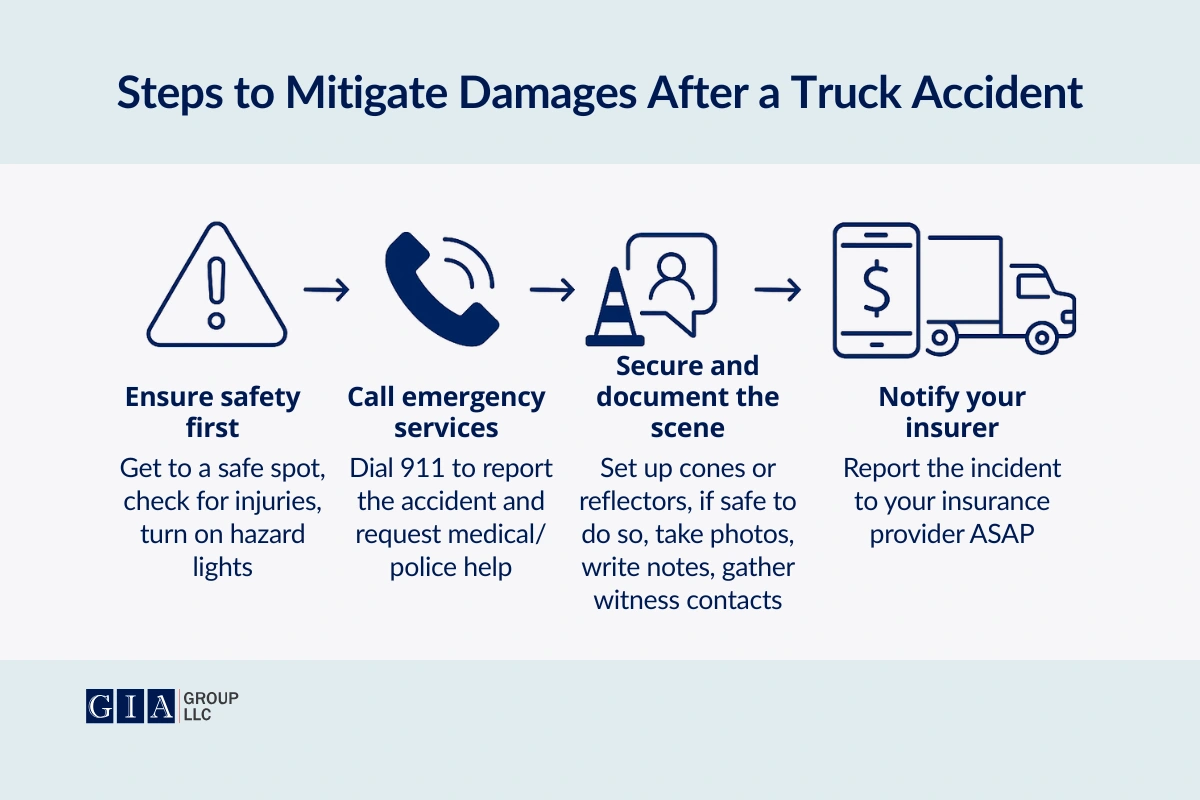Accidents on the road are an unfortunate reality for truckers, but how you respond immediately after an accident can significantly impact the outcome of any claims or legal proceedings that follow.
One of the key responsibilities as a trucker is the duty to mitigate damages. This means taking proactive steps to minimize further harm to people, property, and cargo in the aftermath of an accident. In this article, we’ll explore the duties of a trucker in these situations and provide practical tips on how to protect both your truck and the shipper’s cargo.
Understanding the Duty to Mitigate Damages
The duty to mitigate damages is the legal obligation to take reasonable actions to prevent further harm after an accident. As a trucker, failing to do so could not only exacerbate the situation but may also lead to increased liability or a reduction in the compensation you can claim. This duty applies to various aspects, including your truck, the cargo, and other property involved in the accident.

Steps to Minimize Damage After an Accident
1. Ensure Safety First
-
Contact Authorities
Immediately after an accident, assess the situation for any injuries to yourself, other drivers, or pedestrians. Call emergency services if needed.
-
Move to a Safe Location
If possible and without causing further harm, move your truck out of the flow of traffic to prevent additional accidents.
2. Notify Authorities and Your Company
-
Contact Authorities
Always report the accident to the local authorities, regardless of its severity. An official police report can be crucial for insurance claims and legal proceedings.
-
Notify Your Company
Inform your company’s safety department or management team immediately. Prompt communication ensures that your company can take appropriate actions, assist with the claims process, and provide further instructions.
3. Secure the Scene
-
Use Warning Devices
Deploy reflective triangles, flares, or cones around the accident scene to warn other drivers and prevent further collisions.
-
Turn on Hazard Lights
This alerts other drivers to the situation and can help avoid additional accidents.
4. Protect the Cargo
-
Assess the Cargo’s Condition
After ensuring your own safety and securing the scene, check the condition of the cargo. This is especially crucial if the cargo belongs to the shipper.
-
Prevent Further Damage
If the cargo is exposed or at risk of further damage due to weather conditions or the position of the truck, take steps to protect it. This might involve covering the cargo with tarps or securing it better to prevent shifting.
5. Document the Accident
-
Take Photos and Videos
Capture detailed images of the scene, your truck, the cargo, and any other vehicles involved. This documentation will be critical in the claims process.
-
Record Important Details
Write down the contact information of witnesses, the positions of the vehicles, and any other relevant details that could assist in an investigation or legal case.
Handling Truck and Cargo Damage
Truck Damage
If your truck has sustained damage, it’s vital to take steps to prevent it from worsening:
-
Assess Drivability
Determine if the truck is still safe to drive. If not, arrange for it to be towed to avoid causing more damage.
-
Report the Damage
Notify your company and your insurance provider immediately. Provide them with the documentation you’ve gathered from the scene.
Cargo Damage
When the cargo has been damaged in the accident, especially if it belongs to the shipper, your responsibilities include:
-
Notify the Shipper
Inform the shipper of the damage as soon as possible. Transparency is key in these situations.
-
Mitigate Loss
If there’s a chance to salvage or protect the cargo, do so. This could involve moving undamaged goods to another location or vehicle.
Managing Storage Fees, Additional Damage, and Insurance Coordination
If your truck or cargo is moved to a storage facility that incurs fees, it’s essential to take immediate steps to minimize these costs. Truckers and their companies should make a reasonable attempt to relocate the damaged property to a storage-free facility as soon as it is safe to do so. However, it’s equally important to ensure that the damaged property does not sustain additional damage or theft during this process. This may involve using secure storage options or closely monitoring the transfer and storage of the property.
Additionally, it’s crucial to coordinate with your trucking insurance company to ensure they are aware of the claim and can inspect the damage on time. Maintaining clear communication with your insurer can help avoid complications and ensure that all necessary steps are taken to mitigate further losses.
Furthermore, truckers must meticulously record all expenses incurred as a result of the accident. When selecting vendors for towing, storage, or repairs, choose those who offer reasonable fees to minimize out-of-pocket expenses. Proper documentation and cost management are not only vital for the claims process but also to protect your financial interests.
Legal Considerations
Understanding your insurance coverage is crucial. Commercial truck insurance typically covers liability, but you should be aware of your policy’s specifics regarding cargo damage and truck repairs. Additionally, failure to mitigate damages can lead to disputes with insurance companies or shippers, potentially reducing the compensation you receive.
Conclusion
Mitigating damages after an accident is not just about fulfilling legal obligations—it’s about protecting your livelihood and maintaining professional integrity. By acting quickly and responsibly, you can minimize the financial and legal repercussions of an accident. Always prioritize safety, notify authorities and your company, secure the scene, protect the cargo, and document everything meticulously to ensure the best possible outcome.
Stay safe out there, and remember that how you handle the moments after an accident can make all the difference.
